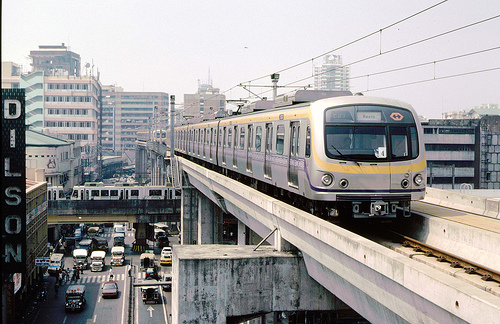A unified ticketing system may finally alleviate Metro Manila’s slow train ticketing system. But I don’t think that can solve any problem. Here’s why.
The Parable of the Train Passenger
In Valenzuela, a city just north of Manila, Julie wakes up at 5am and prepares to head to the office. Her workplace is 25 kilometers away, in Quezon City, which also happens to be Metro Manila’s largest and most populous area. After the necessary preparations, she’s finally at a transport vehicle going to the MRT, or Metro Rail Transit System, just one of Manila’s three train lines.
By the time she arrives in the office, it is already pass 8am. Three hours after she woke up.
Part of Julie’s daily commuting habits is taking the MRT. She’ll take the train from North Avenue station to Kamuning. This is just three stations away. The actual train ride is just 7 minutes. What takes up most of the time is the long queue of people waiting to get on board. The lines are so long it actually takes up the entire street block.

What could be worse than Julie’s situation? Someone who has to board the MRT only to hop onboard another one. This is the case of Miguel. To go to and from work, he has to ride the MRT from North Avenue station to Cubao Station, where he will ride another train system – the MRT 2. This means he has to line up for tickets twice, and wait for the trains twice – a burden that costs a person something very valuable in this fast-paced world – time.
But Miguel and Julie’s daily train rides might become a little more comfortable soon.
A Proposed Unified Train Ticketing System
The Philippines’ Transportation Department is currently undertaking a project that aims to automate the ticketing system in Manila’s three primary train lines. This is what was proposed: a common system in the entire metro’s train network.
If this becomes a reality, Miguel can now used the same ticket he used in the MRT to ride the MRT 2, provided it still has some cash. It should be noted that the three train systems in Manila – the LRT, the MRT, and the MRT 2, sell stored-value tickets. These tickets are 100 pesos in value and can be used for as long as it has cash remaining. When used up, the commuter have to buy another one.
With the unified train system, only one ticket is needed to board the trains. Only one stored-value card that can be used on all the train systems.
Sometime last week, the government has opened the bidding for the project. A joint partnership between Ayala Corporation and Metro Pacific Investments has won the bidding temporarily, with the goal of making the Philippines’ train lines be automated, like the trains of Singapore and Hong Kong.
As much as a unified train ticketing system is something to look forward to, it is not something that can solve the major problem in the train system these days, which is the bulk number of passengers riding it everyday.
The Real Problem Is Not The Current System, But the Lack of Trains
It is estimated that 650,000 people ride the MRT everyday. Adding the numbers on the LRT and the MRT 2, more than a million people ride Manila’s train systems everyday. The most number of them take the trains just before 8 AM during the day, and just before 9PM at night. The timing corresponds with the time people go to the office and schools and going back home during rush hours.
How can this be resolved?
Simple – more trains.
Even when the trains get the eventual unified ticketing system, the enormous number of passengers can still overwhelm the train stations’ platforms. The problem is not the ticketing system, but the number of trains currently serving Manila everyday.
This problem is more pronounced in the MRT, where I also hop onboard everyday at 7 AM. I always have the stored-value ticket. That means I no longer have to fall in queue for the ticket purchasing. However, the sheer volume of people on the train platform is so big we all have to fall in queue and wait till the number of people in the station decreases. The problem? The trains that come to the station are already full, hence only one or two persons can ride from that station.
Currently, there are only 19 trains running on the MRT everyday. The official document states that there are 20 trains, but I asked around in one of the stations, and one official told me there are only 19. 19 trains to serve the thousands of people riding it every morning. There’s a reason why Julie and Miguel arrive late in the office. It’s not because they wake up late, but because their trains arrive later. Without proper scheduling, trains arrive in the stations in no particular times, leaving a person clueless if there’s a train on the way.
According to the country’s Department of Transportation and Communication, it will be in 2016 when new trains for the MRT will arrive for operation.
Increased Fare Matrix
Of course, the unified tickets is a good start. The government is also planning on increasing the train fare matrix. This move has been met with criticism from various labor groups and passengers alike.
For one, the government has enough funds to subsidize the trains, if only corruption can be alleviated. Two, the nation as a whole had just experienced a number of calamities and (gasp!) commodity increase, such as gas, electricity, and water price hikes. As Sammy Malunes, a transport group spokesperson has pointed out, if something should change, “it should be the one-sided and onerous contracts entered by the government with private companies.”
While the unified ticketing system is still currently in the processed of being finalized, it’ll be after two weeks before everything can be decided upon. If everything turns out fine, the project will be starting next year.
Who knows, soon Julie, Miguel, and the thousands of people riding Manila’s train systems will have a little less to worry about before 2014 ends. But again, this is just one piece of the puzzle, as fare hikes and the undersupply of trains may still plague Manila’s train system even after 2014.
Maybe soon, Filipinos won’t have to experience this:
or even this:
Read Stories: Is COMET The Jeepney Alternative Manila Needs?













